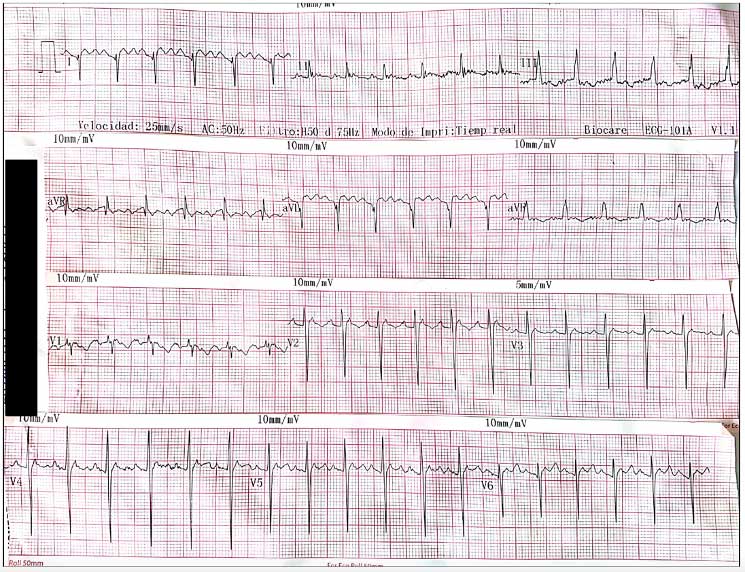A 30-year-old patient with a corrected congenital heart disease who reported dyspnea and palpitations of 1 month’s evolution. Presents the following ECG. What is the most likely diagnosis?
1. Atrial fibrillation
See answer 3: Atypical Atrial Flutter.
2. Atrial tachycardia
See answer 3: Atypical Atrial Flutter.
3. Atypical Atrial Flutter
The ECG shows a regular narrow QRS tachycardia at 135 bpm. Identification of atrial activity during tachycardia can be difficult if only a few leads are observed (DI AVL, for example) where the P is superimposed on the T wave. However, in V1 the atrial activity can be easily discernible from the wave T. Atrial activity during tachycardia is seen to be organized and regular, ruling out atrial fibrillation. The morphology of the atrial activity rules out a sinus origin. Finally, the history of surgically corrected congenital heart disease and the regularity of the LC (220 ms) of atrial activity favor the diagnosis of atrial flutter. Although it is common to find continuous atrial activity on the surface ECG during flutter, in patients with congenital heart disease, the presence of extensive scarring, areas of low voltage, and atypical circuits mean that surface expression of atrial activity may not be continuous.
Characterization of the arrhythmia with a 3D browser revealed macro reentrant tachycardia with slow conduction zone in the lower lateral region of the right atrium. The punctual application of radiofrequency at that point effectively terminated the tachycardia.
Dr. David Doiny
Cardiólogo especialista en Electrofisiología. Miembro Titular de la Sociedad Argentina de Cardiología (SAC)
Ex director del Consejo de Arritmias de la SAC
Especialista certificado EHRA-LAHRS
Sanatorio Finochietto, FLENI y Hospital Central de Pilar, Buenos Aires, Argentina.
Referências
- Waldmann V, Bessière F, Raimondo C, Maltret A, Amet D, Marijon E, Combes N. Atrial flutter catheter ablation in adult congenital heart diseases. Indian Pacing Electrophysiol J. 2021 Sep-Oct;21(5):291-302. doi: 10.1016/j.ipej.2021.06.003. Epub 2021 Jun 19. PMID: 34157427; PMCID: PMC8414331.
- Roca-Luque I, Rivas Gándara N, Dos Subirà L, Pascual JF, Domenech AP, Pérez-Rodon J, Subirana MT, Santos Ortega A, Miranda B, Rosés-Noguer F, Ferreira-Gonzalez I, Ferrer JC, García-Dorado García D, Mitjans AM. Intra-atrial re-entrant tachycardia in congenital heart disease: types and relation of isthmus to atrial voltage. Europace. 2018 Feb 1;20(2):353-361. doi: 10.1093/europace/eux250. PMID: 29016802.
4. Sinus tachycardia
See answer 3: Atypical Atrial Flutter.

